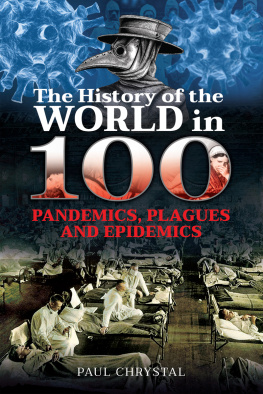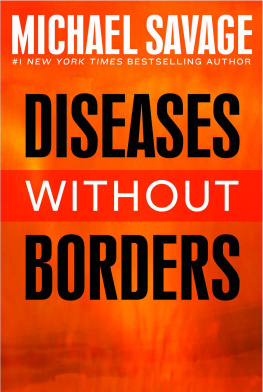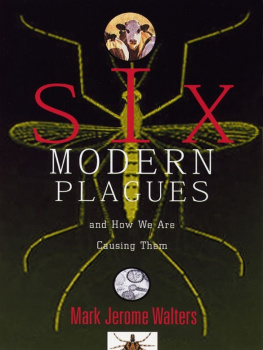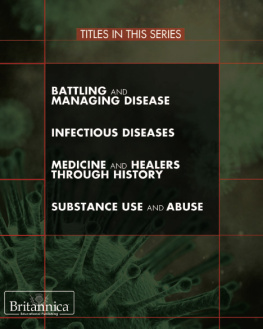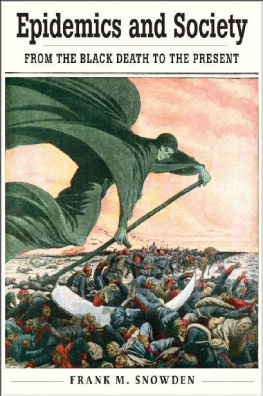Address editorial correspondence to ASM Press, 1752 N St. NW, Washington, DC 20036-2904, USA
Send orders to ASM Press, P.O. Box 605, Herndon, VA 20172, USA
Sherman, Irwin W.
The power of plagues /Irwin W. Sherman.
p. ; cm.
Includes bibliographical references and index.
ISBN-13: 978-1-55581-356-7 (alk. paper)
ISBN-10: 1-55581-356-9 (alk. paper)
1. Communicable diseasesHistory. 2. EpidemicsHistory. 3. Diseases and history. I. American Society for Microbiology. II. Title
[DNLM: 1. Communicable Diseaseshistory. 2. Communicable Disease Conrolhistory. 3. Disease Outbreakshistory. WC 11.1 S553p 2006]
Cover photo: The Four Horseman of the Apocalypse by Daniel Stolpe. Hand-pulled lithograph, 21 48 inches, 1995. www.nativeimagesgallery.com.
Preface
Plagues, the historian Asa Briggs observed, are a dramatic unfolding of events; they are stories of discovery, reaction, conflict, illness and resolution. They test the efficiency and resilience of local and administrative structures and expose the relentlessly political, social and moral shortcomings...rumors, suspicions, and at times violent... conflicts. This book was written to make the science of epidemic diseasesplaguesaccessible and understandable. It is a guide through the maze of contagious diseases, their past importance, the means by which we came to understand them, and how they may affect our future.
In 1976 I purchased Plagues and Peoples by the University of Chicago historian, William H. McNeill. That book changed my way of thinking about infectious diseases. McNeill wrote that while carrying out research for a new book, The Rise of the West: A History of the Human Community , he was struck by a perplexing question: how was Hernan Cortez, with an army of less than600 men, able to conquer the millions of subjects of the Aztec empire? Discarding notions about the superiority of the Spaniards because of their guns and horses, McNeill proposed that an epidemic of smallpox broke out among the Aztecs and, because of its selective lethality, had a profound psychological influence on the Indians. There could be no doubt about which side of the struggle enjoyed divine favor... Little wonder then that the Indians accepted Christianity and submitted to Spanish control so meekly... The lopsided impact of infectious disease upon Amerindian populations offered a key to understanding the ease of Spanish conquest of Americanot only militarily, but culturally as well. McNeill went on to hypothesize that the course of history was influenced by human encounters with infectious diseases, especially when an unfamiliar infection attacked a population for the first time. If this were indeed true, he asked, then why did historians neglect the significance of epidemic disease? He answered: it was overlooked because the older records of deaths from disease were so imperfect that the scale and significance were lost. Further, modern day historians, conditioned by their own experiences with epidemic infections in which immunity tended to limit the severity of the outbreak, tended to consider older accounts of massive die-offs as gross exaggerations. In other words, there was (with rare exceptions such as the Black Death) a failure of historians to appreciate the differences in outcome between the outbreak of a disease in an experienced population and the ravages of the same infection when loosed on a community lacking acquired immunities.
McNeill went on to write that the assumption made by many historians was that infections were always the same as those experienced by Europeans before the advent of modern medicine and therefore historical treatises mentioned epidemics not at all or only casually. Further, because epidemic diseases appeared to have an unpredictable quality and because they lacked the decisiveness of wars or natural catastrophes such as floods and volcanic eruptions, historians were left with an uncomfortable feeling. Disease, with its lack of predictability, did not seem to fit into a larger picture of human history and so it was of little interest to the serious professional historian. McNeills aim was to bring the history of infectious diseases into the realm of historical explanation by showing how varying patterns of disease circulation have affected human affairs in ancient as well as modern times.
A decade later the world was faced with the ever-expanding AIDS epidemic, and most of us were suffering from historical amnesia with regard to disease. I soon realized that a new book on disease and history could help to bridge the gap in the understanding of plagues and their impact on lives past, present, and future. McNeills objective was to place infectious disease in a historical context. Mine was also to provide this, but as a biologist I also wanted to describe the nature and evolution of diseases and then to show how the past could prepare us for future encounters with infectious diseases. In 1986, most of us were unfamiliar with typhus, diphtheria, whooping cough, malaria, sleeping sickness, or snail fever. If we had heard about sexually transmitted diseases other than AIDS, such as syphilis and herpes, we didnt know much about the different kinds of parasites that were responsible. Most people under the age of 25 lacked a smallpox vaccination scar because the disease had been eradicated. Indeed, it was a commonly held belief that all diseases in the developed world had been eliminated by vaccines or soon would be. If not, we assured ourselves, we could rely on new drugs such as antibiotics to cure every new disease. We were convinced that our water was safe to drink and our food could be eaten with little fear of contracting a disease. We were sure that the transmitters of diseasemosquitoes, flies, lice, and fleascould easily be eliminated by insecticides, and if by chance an individual did become infected, we were confident that that person could be treated quickly and effectively and thus disease spread would be curbed.
These views were to change rather quickly: drug-resistant tuberculosis emerged as a worldwide threat, and there were outbreaks of Ebola, hantavirus pulmonary syndrome, and SARS (severe acute respiratory syndrome). In the summer of 1999, an outbreak of West Nile virus (WNV) caused illness in 62 people and 7 died. This took place in New York City, not Africa. By 2003, WNV, spread by infected birds, was present throughout the United States. A particularly lethal bird influenzaone that killed millions of animals in a dozen Asian countriescaused alarm in 2004. This virus, which rarely infects humans, spread rapidly in the human population and killed 42 people. If this new flu had been able to be transmitted from person-to-person by coughing, sneezing, or even a handshake, then a natural bioterrorist attack would have occurred. Luckily, that did not happen, but the prediction is this: in the foreseeable future it will occur and there will be no place for us to hide. ( discusses WNV and the manner by which new flu strains emerge.) Clearly, in a very short time all of us began to appreciate that epidemic disease was not a thing of our past.
This book has been conceived as a conversation about how we came to understand the nature of severe outbreaks of epidemic diseaseplagues, if you will. It tells about scientists and how they discovered the causes and developed controls for infectious diseases, as well as the ways in which plagues and culture interact to shape values, traditions, and the institutions of Western civilization. It also provides a status reportwhere we are today with epidemic diseasesand offers possible solutions to the coming plagues such as malaria, tuberculosis, cholera, AIDS, mad cow disease, influenza, and West Nile.


